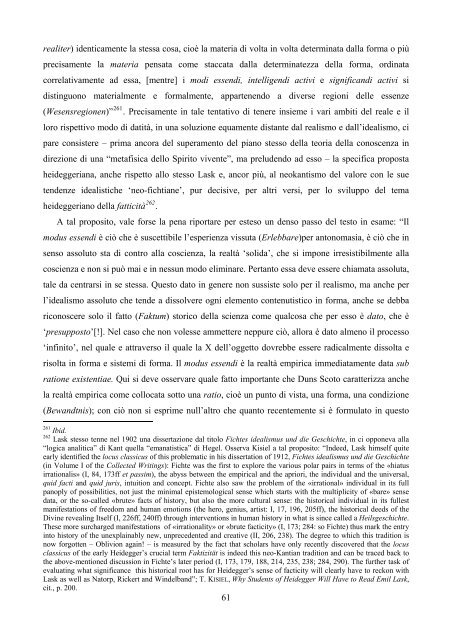"ricerche logiche" di Martin Heidegger - FedOA - Università degli ...
"ricerche logiche" di Martin Heidegger - FedOA - Università degli ...
"ricerche logiche" di Martin Heidegger - FedOA - Università degli ...
You also want an ePaper? Increase the reach of your titles
YUMPU automatically turns print PDFs into web optimized ePapers that Google loves.
ealiter) identicamente la stessa cosa, cioè la materia <strong>di</strong> volta in volta determinata dalla forma o più<br />
precisamente la materia pensata come staccata dalla determinatezza della forma, or<strong>di</strong>nata<br />
correlativamente ad essa, [mentre] i mo<strong>di</strong> essen<strong>di</strong>, intelligen<strong>di</strong> activi e significan<strong>di</strong> activi si<br />
<strong>di</strong>stinguono materialmente e formalmente, appartenendo a <strong>di</strong>verse regioni delle essenze<br />
(Wesensregionen)” 261 . Precisamente in tale tentativo <strong>di</strong> tenere insieme i vari ambiti del reale e il<br />
loro rispettivo modo <strong>di</strong> datità, in una soluzione equamente <strong>di</strong>stante dal realismo e dall’idealismo, ci<br />
pare consistere – prima ancora del superamento del piano stesso della teoria della conoscenza in<br />
<strong>di</strong>rezione <strong>di</strong> una “metafisica dello Spirito vivente”, ma preludendo ad esso – la specifica proposta<br />
heideggeriana, anche rispetto allo stesso Lask e, ancor più, al neokantismo del valore con le sue<br />
tendenze idealistiche ‘neo-fichtiane’, pur decisive, per altri versi, per lo sviluppo del tema<br />
heideggeriano della fatticità 262 .<br />
A tal proposito, vale forse la pena riportare per esteso un denso passo del testo in esame: “Il<br />
modus essen<strong>di</strong> è ciò che è suscettibile l’esperienza vissuta (Erlebbare)per antonomasia, è ciò che in<br />
senso assoluto sta <strong>di</strong> contro alla coscienza, la realtà ‘solida’, che si impone irresistibilmente alla<br />
coscienza e non si può mai e in nessun modo eliminare. Pertanto essa deve essere chiamata assoluta,<br />
tale da centrarsi in se stessa. Questo dato in genere non sussiste solo per il realismo, ma anche per<br />
l’idealismo assoluto che tende a <strong>di</strong>ssolvere ogni elemento contenutistico in forma, anche se debba<br />
riconoscere solo il fatto (Faktum) storico della scienza come qualcosa che per esso è dato, che è<br />
‘presupposto’[!]. Nel caso che non volesse ammettere neppure ciò, allora è dato almeno il processo<br />
‘infinito’, nel quale e attraverso il quale la X dell’oggetto dovrebbe essere ra<strong>di</strong>calmente <strong>di</strong>ssolta e<br />
risolta in forma e sistemi <strong>di</strong> forma. Il modus essen<strong>di</strong> è la realtà empirica imme<strong>di</strong>atamente data sub<br />
ratione existentiae. Qui si deve osservare quale fatto importante che Duns Scoto caratterizza anche<br />
la realtà empirica come collocata sotto una ratio, cioè un punto <strong>di</strong> vista, una forma, una con<strong>di</strong>zione<br />
(Bewandtnis); con ciò non si esprime null’altro che quanto recentemente si è formulato in questo<br />
261<br />
Ibid.<br />
262<br />
Lask stesso tenne nel 1902 una <strong>di</strong>ssertazione dal titolo Fichtes idealismus und <strong>di</strong>e Geschichte, in ci opponeva alla<br />
“logica analitica” <strong>di</strong> Kant quella “emanatistica” <strong>di</strong> Hegel. Osserva Kisiel a tal proposito: “Indeed, Lask himself quite<br />
early identified the locus classicus of this problematic in his <strong>di</strong>ssertation of 1912, Fichtes idealismus und <strong>di</strong>e Geschichte<br />
(in Volume I of the Collected Writings): Fichte was the first to explore the various polar pairs in terms of the «hiatus<br />
irrationalis» (I, 84, 173ff et passim), the abyss between the empirical and the apriori, the in<strong>di</strong>vidual and the universal,<br />
quid facti and quid juris, intuition and concept. Fichte also saw the problem of the «irrational» in<strong>di</strong>vidual in its full<br />
panoply of possibilities, not just the minimal epistemological sense which starts with the multiplicity of «bare» sense<br />
data, or the so-called «brute» facts of history, but also the more cultural sense: the historical in<strong>di</strong>vidual in its fullest<br />
manifestations of freedom and human emotions (the hero, genius, artist: I, 17, 196, 205ff), the historical deeds of the<br />
Divine revealing Itself (I, 226ff, 240ff) through interventions in human history in what is since called a Heilsgeschichte.<br />
These more surcharged manifestations of «irrationality» or «brute facticity» (I, 173; 284: so Fichte) thus mark the entry<br />
into history of the unexplainably new, unprecedented and creative (II, 206, 238). The degree to which this tra<strong>di</strong>tion is<br />
now forgotten – Oblivion again! – is measured by the fact that scholars have only recently <strong>di</strong>scovered that the locus<br />
classicus of the early <strong>Heidegger</strong>’s crucial term Faktizität is indeed this neo-Kantian tra<strong>di</strong>tion and can be traced back to<br />
the above-mentioned <strong>di</strong>scussion in Fichte’s later period (I, 173, 179, 188, 214, 235, 238; 284, 290). The further task of<br />
evaluating what significance this historical root has for <strong>Heidegger</strong>’s sense of facticity will clearly have to reckon with<br />
Lask as well as Natorp, Rickert and Windelband”; T. KISIEL, Why Students of <strong>Heidegger</strong> Will Have to Read Emil Lask,<br />
cit., p. 200.<br />
61

















